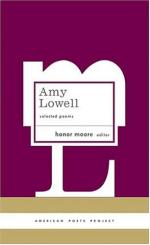|
This section contains 6,511 words (approx. 22 pages at 300 words per page) |

|
SOURCE: "Imagist and Impassionist: The Major Lyrics," in Amy Lowell, Twayne Publishers, 1985, pp. 120-39.
In the following essay, Benvenuto examines the stylistic and thematic aspects of Lowell's lyrical poetry in the collections, Pictures of the Floating World and What's O'Clock.
While [Amy] Lowell was writing the dramatic and narrative poems of Men, Women and Ghosts, Can Grande's Castle, and Legends, she was developing steadily as a lyric poet as well…. [Her] discovery of imagism resulted in such finely wrought lyrics as "Taxi" and "Aubade" in Sword Blades and Poppy Seed. And although she often wrote with other ends in mind than those of imagism, the imagist principles taught her to focus on relevant detail and on sensory, nondiscursive language, and to value such qualities as concision and vividness as the identifying traits of modern poetry. Pictures of the Floating World, published in 1919, and What's O'Clock, published posthumously in...
|
This section contains 6,511 words (approx. 22 pages at 300 words per page) |

|


